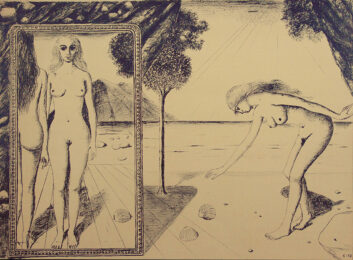

Belgian Paul Delvaux was born in 1897 and was famed as a surrealist painter. As a young man he read classic works such as Homer, and would sketch mythological scenes inspired by his reading. Despite pressure from his parents to study architecture, Delvaux was committed to a career in fine art and chose to study at the Belgian Academy of Arts in Brussels, enrolling in several art classes.
His early career saw him paint naturalistic landscapes and nudes. As his work progressed, it began to take on a more sensual overtone and many of his later works depict female nudes in dream like states in and around grand buildings. Delvaux’s most famous paintings include The Hands (1941), Venus Asleep (1944) and The Great Sirens (1947). His work has been influenced by artists Rene Margritte, Giorgio de Chirico and Gustave de Smet.
In terms of fame, Delvaux is somewhat overshadowed by Salvador Dali, yet he is still thought of as an influential contributor to the surrealist and modern art movements of the mid-twentieth century. Paul Delvaux passed away at the grand age of 96 in Veurne in 1994, and has a museum dedicated to his work and his legacy in the Belgian town of Sint-Idesbald.